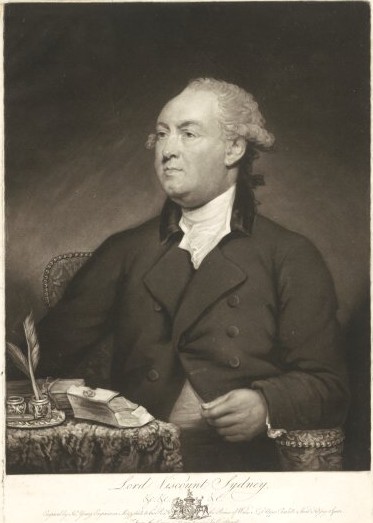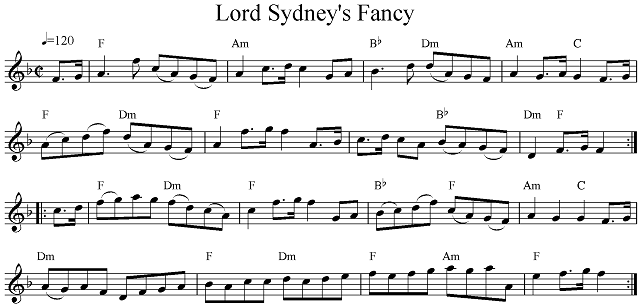Within days of the arrival of the First Fleet at Botany Bay, Governor Phillip realised the proposed site was inadequate for the settlement. The bay was too shallow for ships to come in close to shore, the soil was poor and there was only a trickle of drinking water. A small party in open boats sailed north to explore Port Jackson and discovered “the finest harbour in the world” . On 26 January, 1788, the Fleet anchored in Sydney Cove, named in honour of the Home Secretary and the settlement became known as Sydney Town.
Thomas Townshend, Lord Sydney, was the British Home secretary responsible for finding a solution to the convict problem. Having steered the Felons Transportation Act through the Parliament in 1784, Townshend felt the Government owed a duty of care to the convicts. A trial scheme for transportation to Africa had proved disastrous due to the high rate of disease and was gauged the equivalent of a death sentence – Botany Bay seemed a safer option.
Arthur Phillip and Townshend had a close personal relationship which transcended the Admiralty hierarchy. To the surprise of the Admiralty, Townshend had appointed Phillip to the command, confident in his abilities as farmer, explorer, builder and as a compassionate leader. Townshend had given Phillip his absolute support and took extra measures to ensure the success of the venture, in one instance he doubled the number of stores recommended by Joseph Banks.
Phillip must have felt intense gratitude to Townshend when the fleet arrived safely in the new land. Others echoed this sentiment:
To see all the ships safe in their destined port,…and all the people in as good health as could be expected or hoped for, after so long a voyage, was a sight truly pleasing, and at which every heart must rejoice.John White, Chief Surgeon.
Thomas Townshend was a very significant political figure during the 1780s with enlightened and progressive ideas. In 1783 he was created Baron Sydney and in 1789 was elevated to 1st Viscount Sydney. After Lord Sydney retired from politics, his interest in the colony continued and he extended hospitality to the two aborigines, Bennelong and Yemmerrawannie, who were taken to England by Governor Phillip in 1793.
It was not unusual for an aging lord to have a dance named in his honour – the name fancy being used in the context of a favourite dance. The following excerpt demonstrates the importance of dance as a principal recreation in the late eighteenth century:
The gravest of men here, with the exception of the ministers, think it no disgrace to dance. I have seen a professor, who has argued most learnedly and most wisely in the morning, forgetting all his gravity in an evening and dancing away to the best of his abilities.Edward Topham’s visit to Edinburgh 1770, The Darling Diversion.
Listen to Lord Sydney’s Fancy Arr. Roland Clarke.
Country dance: triple minor longways
A1 1-8 Hey on contrary sides
A2 1-8 Hey on own sides.
B1 1-8 1st couple lead down the middle and back, cast off.
B2 1-8 Rights and lefts at the top.
Also known as Lord Townshend’s Fancy.
Twenty Four Country Dances for the Year 1789. Longman and Broderip, London
_________________________________________________________________________________________________________________________
The Brisbane-based dance group Kaleidoscope has an animation of Lord Sydney’s Fancy which shows the basic pattern of the dance.
Visit them at http://www.dancekaleidoscope.org.au/dance.html
___________________________________________________________________________________________________________________________________
Sources
Christopher, Emma. A Merciless Place. The lost story of Britain’s convict disaster in Africa and how it led to the settlement of Australia. Allen & Unwin, 2010.
Clune, David & Turner, Ken,(editors) The Governors of New South Wales 1788-2010.
The Federation Press, Sydney, 2010.
Hood, Evelyn. Hood The Darling Diversion. William Collins, Great Britain, 1980.
Parker, Derek. Arthur Phillip. Australia’s First Governor. Woodslane Press, Sydney, 2009.
National Library of Australia. Lord Viscount Sydney [picture] engraved by John Young from the original picture painted by G.Stuart .
______________________________________________________________
The information on this website www.historicaldance.au may be copied for personal use only, and must be acknowledged as from this website. It may not be reproduced for publication without prior permission from Heather Clarke




Pingback: Special Events | Australian Colonial Dance